University Property Law and Real Estate Ethics Project, Semester 1
VerifiedAdded on 2022/08/15
|14
|3723
|14
Project
AI Summary
This document presents a comprehensive solution to a property law project, addressing key concepts in Canadian property law and real estate ethics. The project delves into various aspects, including the appropriate court for a civil suit arising from a neighbor dispute, considering the path to the Supreme Court of Canada and potential obstacles. It analyzes the legal implications of fraudulent misrepresentation in real estate transactions and the ramifications for real estate representatives. The project also explores property ownership structures, specifically joint tenancy, and the potential changes upon selling a share. Furthermore, it examines the legal determination of fixtures versus chattels, and the impact of encumbrances such as caveats, easements, restrictive covenants, and builder's liens on property titles. The solution provides detailed responses to the project questions, demonstrating an understanding of relevant legal principles and practical application within the Canadian context.
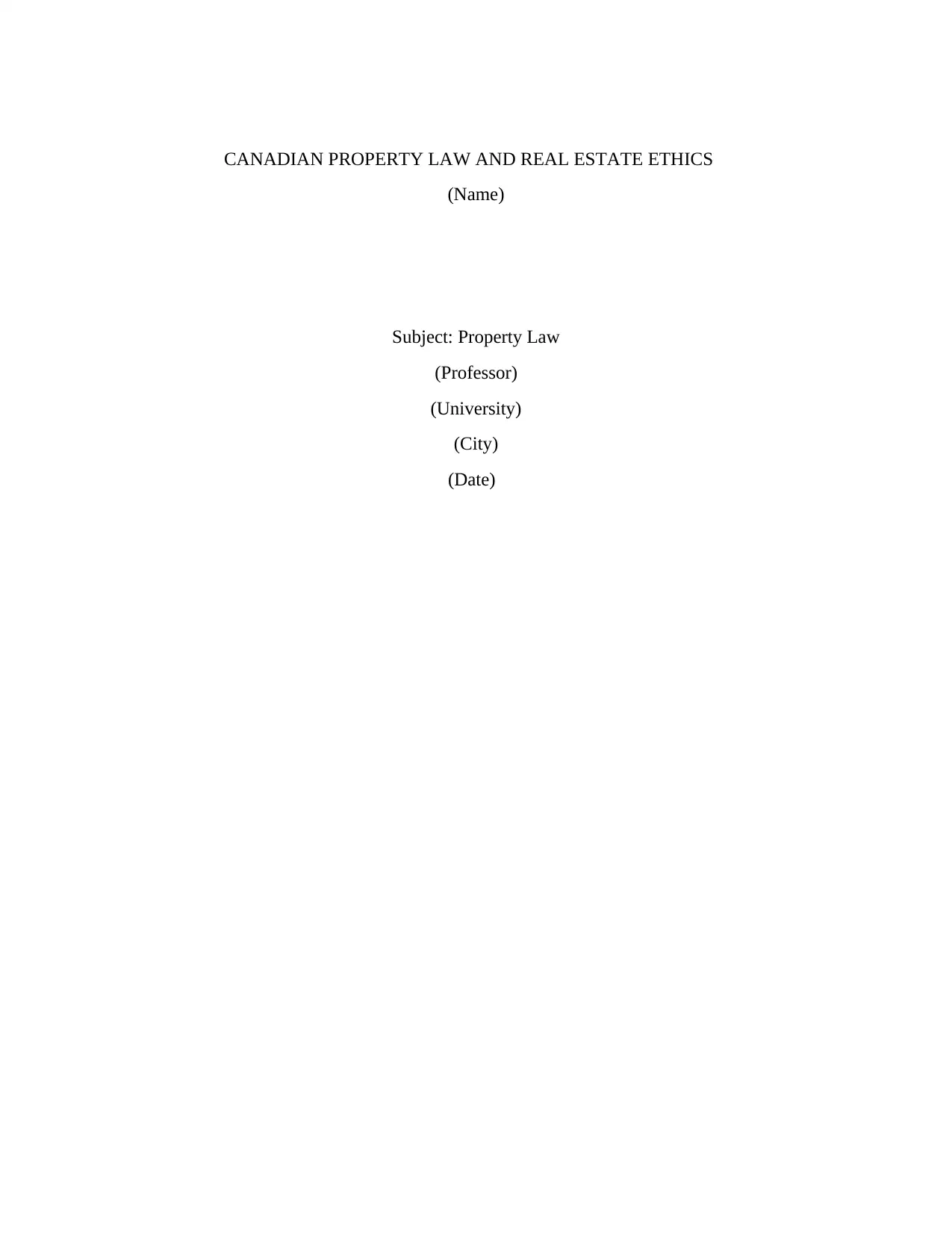
CANADIAN PROPERTY LAW AND REAL ESTATE ETHICS
(Name)
Subject: Property Law
(Professor)
(University)
(City)
(Date)
(Name)
Subject: Property Law
(Professor)
(University)
(City)
(Date)
Paraphrase This Document
Need a fresh take? Get an instant paraphrase of this document with our AI Paraphraser
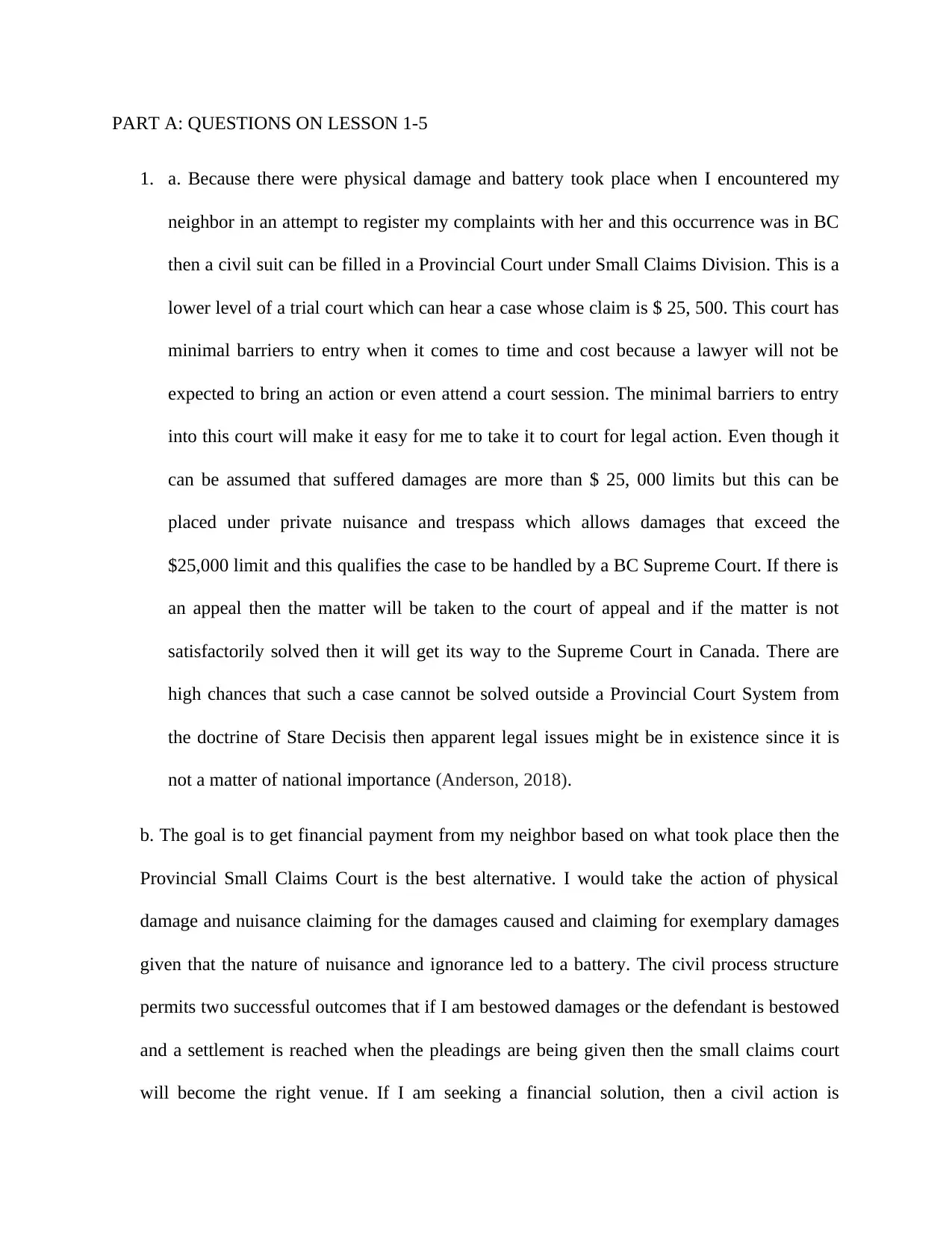
PART A: QUESTIONS ON LESSON 1-5
1. a. Because there were physical damage and battery took place when I encountered my
neighbor in an attempt to register my complaints with her and this occurrence was in BC
then a civil suit can be filled in a Provincial Court under Small Claims Division. This is a
lower level of a trial court which can hear a case whose claim is $ 25, 500. This court has
minimal barriers to entry when it comes to time and cost because a lawyer will not be
expected to bring an action or even attend a court session. The minimal barriers to entry
into this court will make it easy for me to take it to court for legal action. Even though it
can be assumed that suffered damages are more than $ 25, 000 limits but this can be
placed under private nuisance and trespass which allows damages that exceed the
$25,000 limit and this qualifies the case to be handled by a BC Supreme Court. If there is
an appeal then the matter will be taken to the court of appeal and if the matter is not
satisfactorily solved then it will get its way to the Supreme Court in Canada. There are
high chances that such a case cannot be solved outside a Provincial Court System from
the doctrine of Stare Decisis then apparent legal issues might be in existence since it is
not a matter of national importance (Anderson, 2018).
b. The goal is to get financial payment from my neighbor based on what took place then the
Provincial Small Claims Court is the best alternative. I would take the action of physical
damage and nuisance claiming for the damages caused and claiming for exemplary damages
given that the nature of nuisance and ignorance led to a battery. The civil process structure
permits two successful outcomes that if I am bestowed damages or the defendant is bestowed
and a settlement is reached when the pleadings are being given then the small claims court
will become the right venue. If I am seeking a financial solution, then a civil action is
1. a. Because there were physical damage and battery took place when I encountered my
neighbor in an attempt to register my complaints with her and this occurrence was in BC
then a civil suit can be filled in a Provincial Court under Small Claims Division. This is a
lower level of a trial court which can hear a case whose claim is $ 25, 500. This court has
minimal barriers to entry when it comes to time and cost because a lawyer will not be
expected to bring an action or even attend a court session. The minimal barriers to entry
into this court will make it easy for me to take it to court for legal action. Even though it
can be assumed that suffered damages are more than $ 25, 000 limits but this can be
placed under private nuisance and trespass which allows damages that exceed the
$25,000 limit and this qualifies the case to be handled by a BC Supreme Court. If there is
an appeal then the matter will be taken to the court of appeal and if the matter is not
satisfactorily solved then it will get its way to the Supreme Court in Canada. There are
high chances that such a case cannot be solved outside a Provincial Court System from
the doctrine of Stare Decisis then apparent legal issues might be in existence since it is
not a matter of national importance (Anderson, 2018).
b. The goal is to get financial payment from my neighbor based on what took place then the
Provincial Small Claims Court is the best alternative. I would take the action of physical
damage and nuisance claiming for the damages caused and claiming for exemplary damages
given that the nature of nuisance and ignorance led to a battery. The civil process structure
permits two successful outcomes that if I am bestowed damages or the defendant is bestowed
and a settlement is reached when the pleadings are being given then the small claims court
will become the right venue. If I am seeking a financial solution, then a civil action is
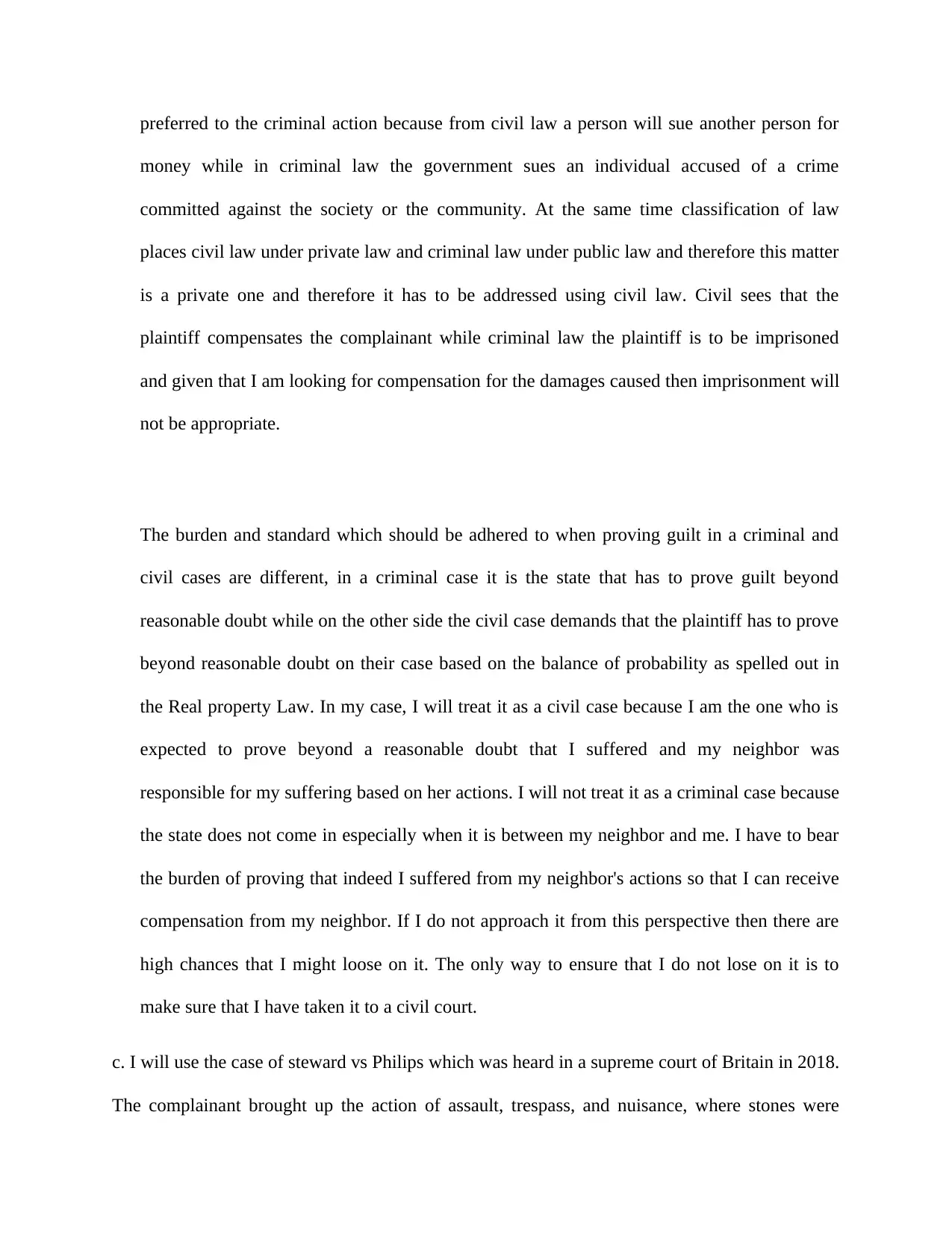
preferred to the criminal action because from civil law a person will sue another person for
money while in criminal law the government sues an individual accused of a crime
committed against the society or the community. At the same time classification of law
places civil law under private law and criminal law under public law and therefore this matter
is a private one and therefore it has to be addressed using civil law. Civil sees that the
plaintiff compensates the complainant while criminal law the plaintiff is to be imprisoned
and given that I am looking for compensation for the damages caused then imprisonment will
not be appropriate.
The burden and standard which should be adhered to when proving guilt in a criminal and
civil cases are different, in a criminal case it is the state that has to prove guilt beyond
reasonable doubt while on the other side the civil case demands that the plaintiff has to prove
beyond reasonable doubt on their case based on the balance of probability as spelled out in
the Real property Law. In my case, I will treat it as a civil case because I am the one who is
expected to prove beyond a reasonable doubt that I suffered and my neighbor was
responsible for my suffering based on her actions. I will not treat it as a criminal case because
the state does not come in especially when it is between my neighbor and me. I have to bear
the burden of proving that indeed I suffered from my neighbor's actions so that I can receive
compensation from my neighbor. If I do not approach it from this perspective then there are
high chances that I might loose on it. The only way to ensure that I do not lose on it is to
make sure that I have taken it to a civil court.
c. I will use the case of steward vs Philips which was heard in a supreme court of Britain in 2018.
The complainant brought up the action of assault, trespass, and nuisance, where stones were
money while in criminal law the government sues an individual accused of a crime
committed against the society or the community. At the same time classification of law
places civil law under private law and criminal law under public law and therefore this matter
is a private one and therefore it has to be addressed using civil law. Civil sees that the
plaintiff compensates the complainant while criminal law the plaintiff is to be imprisoned
and given that I am looking for compensation for the damages caused then imprisonment will
not be appropriate.
The burden and standard which should be adhered to when proving guilt in a criminal and
civil cases are different, in a criminal case it is the state that has to prove guilt beyond
reasonable doubt while on the other side the civil case demands that the plaintiff has to prove
beyond reasonable doubt on their case based on the balance of probability as spelled out in
the Real property Law. In my case, I will treat it as a civil case because I am the one who is
expected to prove beyond a reasonable doubt that I suffered and my neighbor was
responsible for my suffering based on her actions. I will not treat it as a criminal case because
the state does not come in especially when it is between my neighbor and me. I have to bear
the burden of proving that indeed I suffered from my neighbor's actions so that I can receive
compensation from my neighbor. If I do not approach it from this perspective then there are
high chances that I might loose on it. The only way to ensure that I do not lose on it is to
make sure that I have taken it to a civil court.
c. I will use the case of steward vs Philips which was heard in a supreme court of Britain in 2018.
The complainant brought up the action of assault, trespass, and nuisance, where stones were
⊘ This is a preview!⊘
Do you want full access?
Subscribe today to unlock all pages.

Trusted by 1+ million students worldwide
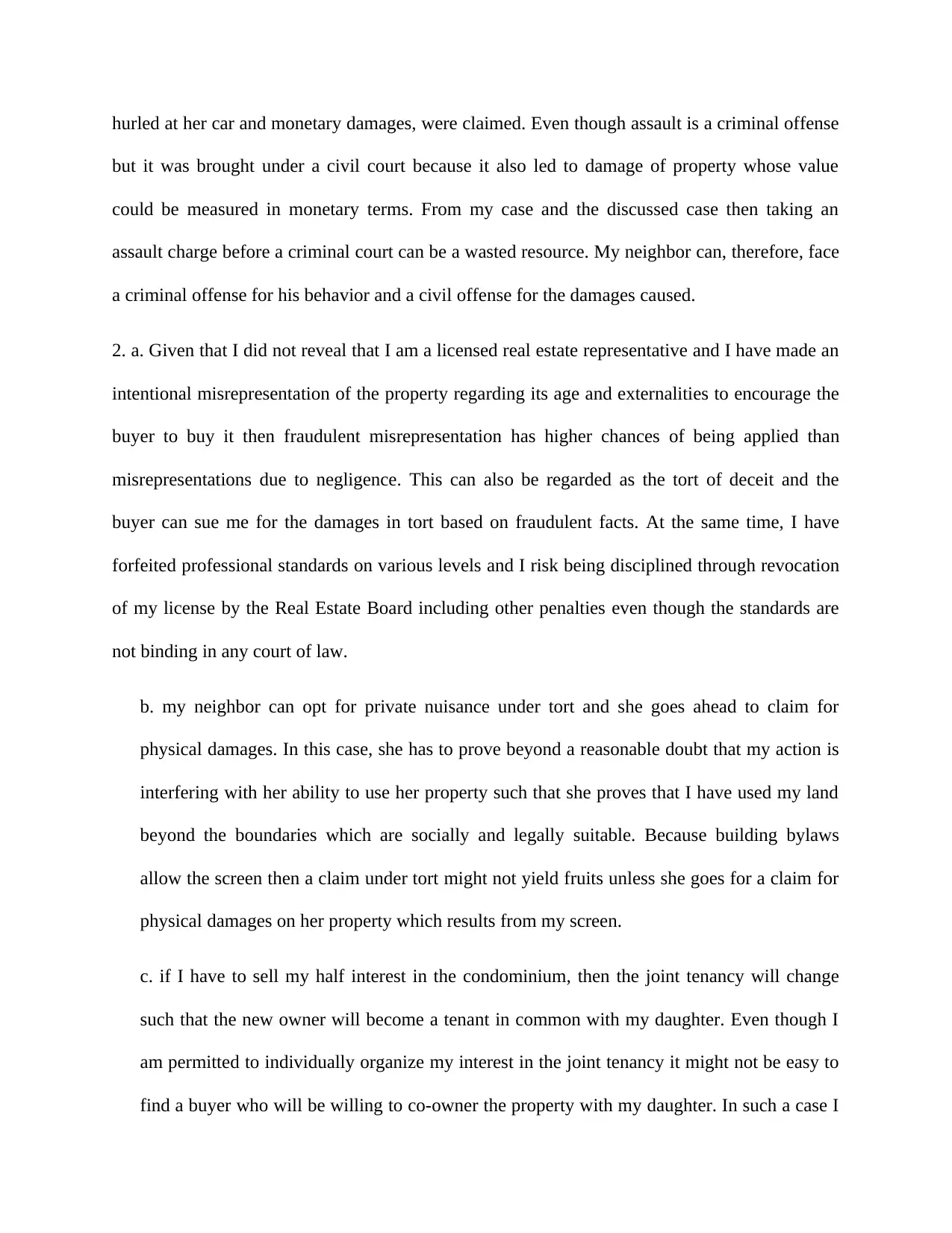
hurled at her car and monetary damages, were claimed. Even though assault is a criminal offense
but it was brought under a civil court because it also led to damage of property whose value
could be measured in monetary terms. From my case and the discussed case then taking an
assault charge before a criminal court can be a wasted resource. My neighbor can, therefore, face
a criminal offense for his behavior and a civil offense for the damages caused.
2. a. Given that I did not reveal that I am a licensed real estate representative and I have made an
intentional misrepresentation of the property regarding its age and externalities to encourage the
buyer to buy it then fraudulent misrepresentation has higher chances of being applied than
misrepresentations due to negligence. This can also be regarded as the tort of deceit and the
buyer can sue me for the damages in tort based on fraudulent facts. At the same time, I have
forfeited professional standards on various levels and I risk being disciplined through revocation
of my license by the Real Estate Board including other penalties even though the standards are
not binding in any court of law.
b. my neighbor can opt for private nuisance under tort and she goes ahead to claim for
physical damages. In this case, she has to prove beyond a reasonable doubt that my action is
interfering with her ability to use her property such that she proves that I have used my land
beyond the boundaries which are socially and legally suitable. Because building bylaws
allow the screen then a claim under tort might not yield fruits unless she goes for a claim for
physical damages on her property which results from my screen.
c. if I have to sell my half interest in the condominium, then the joint tenancy will change
such that the new owner will become a tenant in common with my daughter. Even though I
am permitted to individually organize my interest in the joint tenancy it might not be easy to
find a buyer who will be willing to co-owner the property with my daughter. In such a case I
but it was brought under a civil court because it also led to damage of property whose value
could be measured in monetary terms. From my case and the discussed case then taking an
assault charge before a criminal court can be a wasted resource. My neighbor can, therefore, face
a criminal offense for his behavior and a civil offense for the damages caused.
2. a. Given that I did not reveal that I am a licensed real estate representative and I have made an
intentional misrepresentation of the property regarding its age and externalities to encourage the
buyer to buy it then fraudulent misrepresentation has higher chances of being applied than
misrepresentations due to negligence. This can also be regarded as the tort of deceit and the
buyer can sue me for the damages in tort based on fraudulent facts. At the same time, I have
forfeited professional standards on various levels and I risk being disciplined through revocation
of my license by the Real Estate Board including other penalties even though the standards are
not binding in any court of law.
b. my neighbor can opt for private nuisance under tort and she goes ahead to claim for
physical damages. In this case, she has to prove beyond a reasonable doubt that my action is
interfering with her ability to use her property such that she proves that I have used my land
beyond the boundaries which are socially and legally suitable. Because building bylaws
allow the screen then a claim under tort might not yield fruits unless she goes for a claim for
physical damages on her property which results from my screen.
c. if I have to sell my half interest in the condominium, then the joint tenancy will change
such that the new owner will become a tenant in common with my daughter. Even though I
am permitted to individually organize my interest in the joint tenancy it might not be easy to
find a buyer who will be willing to co-owner the property with my daughter. In such a case I
Paraphrase This Document
Need a fresh take? Get an instant paraphrase of this document with our AI Paraphraser
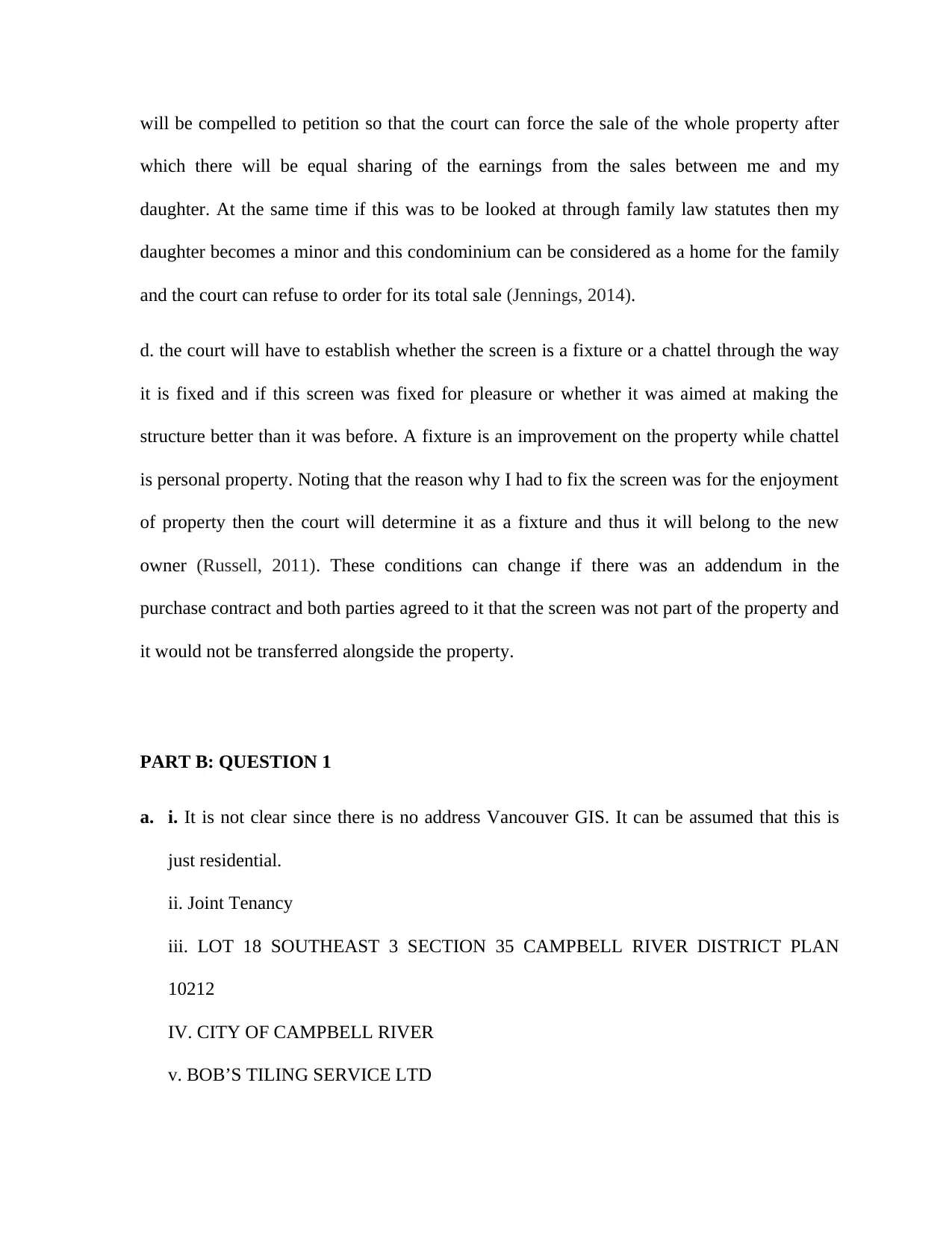
will be compelled to petition so that the court can force the sale of the whole property after
which there will be equal sharing of the earnings from the sales between me and my
daughter. At the same time if this was to be looked at through family law statutes then my
daughter becomes a minor and this condominium can be considered as a home for the family
and the court can refuse to order for its total sale (Jennings, 2014).
d. the court will have to establish whether the screen is a fixture or a chattel through the way
it is fixed and if this screen was fixed for pleasure or whether it was aimed at making the
structure better than it was before. A fixture is an improvement on the property while chattel
is personal property. Noting that the reason why I had to fix the screen was for the enjoyment
of property then the court will determine it as a fixture and thus it will belong to the new
owner (Russell, 2011). These conditions can change if there was an addendum in the
purchase contract and both parties agreed to it that the screen was not part of the property and
it would not be transferred alongside the property.
PART B: QUESTION 1
a. i. It is not clear since there is no address Vancouver GIS. It can be assumed that this is
just residential.
ii. Joint Tenancy
iii. LOT 18 SOUTHEAST 3 SECTION 35 CAMPBELL RIVER DISTRICT PLAN
10212
IV. CITY OF CAMPBELL RIVER
v. BOB’S TILING SERVICE LTD
which there will be equal sharing of the earnings from the sales between me and my
daughter. At the same time if this was to be looked at through family law statutes then my
daughter becomes a minor and this condominium can be considered as a home for the family
and the court can refuse to order for its total sale (Jennings, 2014).
d. the court will have to establish whether the screen is a fixture or a chattel through the way
it is fixed and if this screen was fixed for pleasure or whether it was aimed at making the
structure better than it was before. A fixture is an improvement on the property while chattel
is personal property. Noting that the reason why I had to fix the screen was for the enjoyment
of property then the court will determine it as a fixture and thus it will belong to the new
owner (Russell, 2011). These conditions can change if there was an addendum in the
purchase contract and both parties agreed to it that the screen was not part of the property and
it would not be transferred alongside the property.
PART B: QUESTION 1
a. i. It is not clear since there is no address Vancouver GIS. It can be assumed that this is
just residential.
ii. Joint Tenancy
iii. LOT 18 SOUTHEAST 3 SECTION 35 CAMPBELL RIVER DISTRICT PLAN
10212
IV. CITY OF CAMPBELL RIVER
v. BOB’S TILING SERVICE LTD
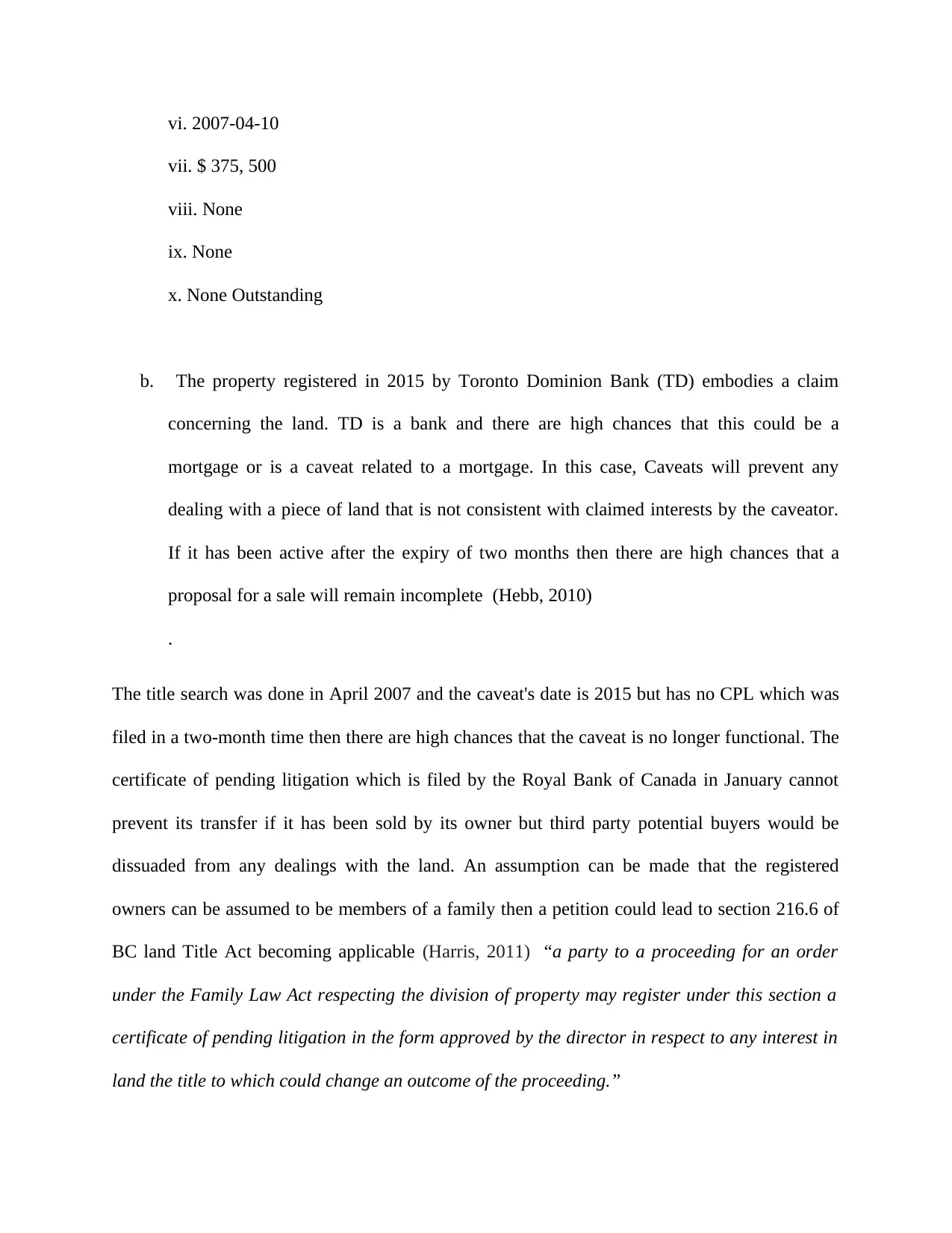
vi. 2007-04-10
vii. $ 375, 500
viii. None
ix. None
x. None Outstanding
b. The property registered in 2015 by Toronto Dominion Bank (TD) embodies a claim
concerning the land. TD is a bank and there are high chances that this could be a
mortgage or is a caveat related to a mortgage. In this case, Caveats will prevent any
dealing with a piece of land that is not consistent with claimed interests by the caveator.
If it has been active after the expiry of two months then there are high chances that a
proposal for a sale will remain incomplete (Hebb, 2010)
.
The title search was done in April 2007 and the caveat's date is 2015 but has no CPL which was
filed in a two-month time then there are high chances that the caveat is no longer functional. The
certificate of pending litigation which is filed by the Royal Bank of Canada in January cannot
prevent its transfer if it has been sold by its owner but third party potential buyers would be
dissuaded from any dealings with the land. An assumption can be made that the registered
owners can be assumed to be members of a family then a petition could lead to section 216.6 of
BC land Title Act becoming applicable (Harris, 2011) “a party to a proceeding for an order
under the Family Law Act respecting the division of property may register under this section a
certificate of pending litigation in the form approved by the director in respect to any interest in
land the title to which could change an outcome of the proceeding.”
vii. $ 375, 500
viii. None
ix. None
x. None Outstanding
b. The property registered in 2015 by Toronto Dominion Bank (TD) embodies a claim
concerning the land. TD is a bank and there are high chances that this could be a
mortgage or is a caveat related to a mortgage. In this case, Caveats will prevent any
dealing with a piece of land that is not consistent with claimed interests by the caveator.
If it has been active after the expiry of two months then there are high chances that a
proposal for a sale will remain incomplete (Hebb, 2010)
.
The title search was done in April 2007 and the caveat's date is 2015 but has no CPL which was
filed in a two-month time then there are high chances that the caveat is no longer functional. The
certificate of pending litigation which is filed by the Royal Bank of Canada in January cannot
prevent its transfer if it has been sold by its owner but third party potential buyers would be
dissuaded from any dealings with the land. An assumption can be made that the registered
owners can be assumed to be members of a family then a petition could lead to section 216.6 of
BC land Title Act becoming applicable (Harris, 2011) “a party to a proceeding for an order
under the Family Law Act respecting the division of property may register under this section a
certificate of pending litigation in the form approved by the director in respect to any interest in
land the title to which could change an outcome of the proceeding.”
⊘ This is a preview!⊘
Do you want full access?
Subscribe today to unlock all pages.

Trusted by 1+ million students worldwide
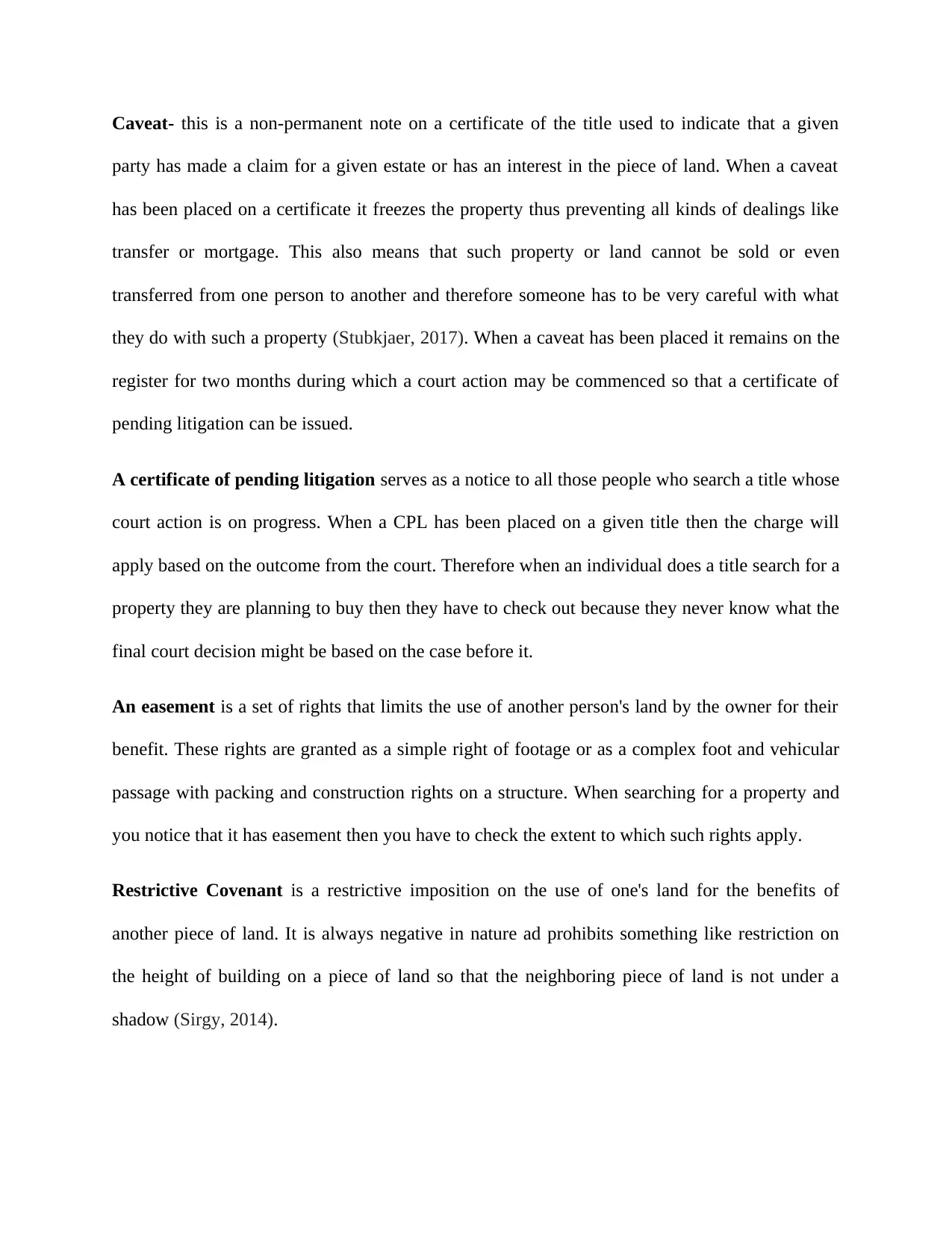
Caveat- this is a non-permanent note on a certificate of the title used to indicate that a given
party has made a claim for a given estate or has an interest in the piece of land. When a caveat
has been placed on a certificate it freezes the property thus preventing all kinds of dealings like
transfer or mortgage. This also means that such property or land cannot be sold or even
transferred from one person to another and therefore someone has to be very careful with what
they do with such a property (Stubkjaer, 2017). When a caveat has been placed it remains on the
register for two months during which a court action may be commenced so that a certificate of
pending litigation can be issued.
A certificate of pending litigation serves as a notice to all those people who search a title whose
court action is on progress. When a CPL has been placed on a given title then the charge will
apply based on the outcome from the court. Therefore when an individual does a title search for a
property they are planning to buy then they have to check out because they never know what the
final court decision might be based on the case before it.
An easement is a set of rights that limits the use of another person's land by the owner for their
benefit. These rights are granted as a simple right of footage or as a complex foot and vehicular
passage with packing and construction rights on a structure. When searching for a property and
you notice that it has easement then you have to check the extent to which such rights apply.
Restrictive Covenant is a restrictive imposition on the use of one's land for the benefits of
another piece of land. It is always negative in nature ad prohibits something like restriction on
the height of building on a piece of land so that the neighboring piece of land is not under a
shadow (Sirgy, 2014).
party has made a claim for a given estate or has an interest in the piece of land. When a caveat
has been placed on a certificate it freezes the property thus preventing all kinds of dealings like
transfer or mortgage. This also means that such property or land cannot be sold or even
transferred from one person to another and therefore someone has to be very careful with what
they do with such a property (Stubkjaer, 2017). When a caveat has been placed it remains on the
register for two months during which a court action may be commenced so that a certificate of
pending litigation can be issued.
A certificate of pending litigation serves as a notice to all those people who search a title whose
court action is on progress. When a CPL has been placed on a given title then the charge will
apply based on the outcome from the court. Therefore when an individual does a title search for a
property they are planning to buy then they have to check out because they never know what the
final court decision might be based on the case before it.
An easement is a set of rights that limits the use of another person's land by the owner for their
benefit. These rights are granted as a simple right of footage or as a complex foot and vehicular
passage with packing and construction rights on a structure. When searching for a property and
you notice that it has easement then you have to check the extent to which such rights apply.
Restrictive Covenant is a restrictive imposition on the use of one's land for the benefits of
another piece of land. It is always negative in nature ad prohibits something like restriction on
the height of building on a piece of land so that the neighboring piece of land is not under a
shadow (Sirgy, 2014).
Paraphrase This Document
Need a fresh take? Get an instant paraphrase of this document with our AI Paraphraser
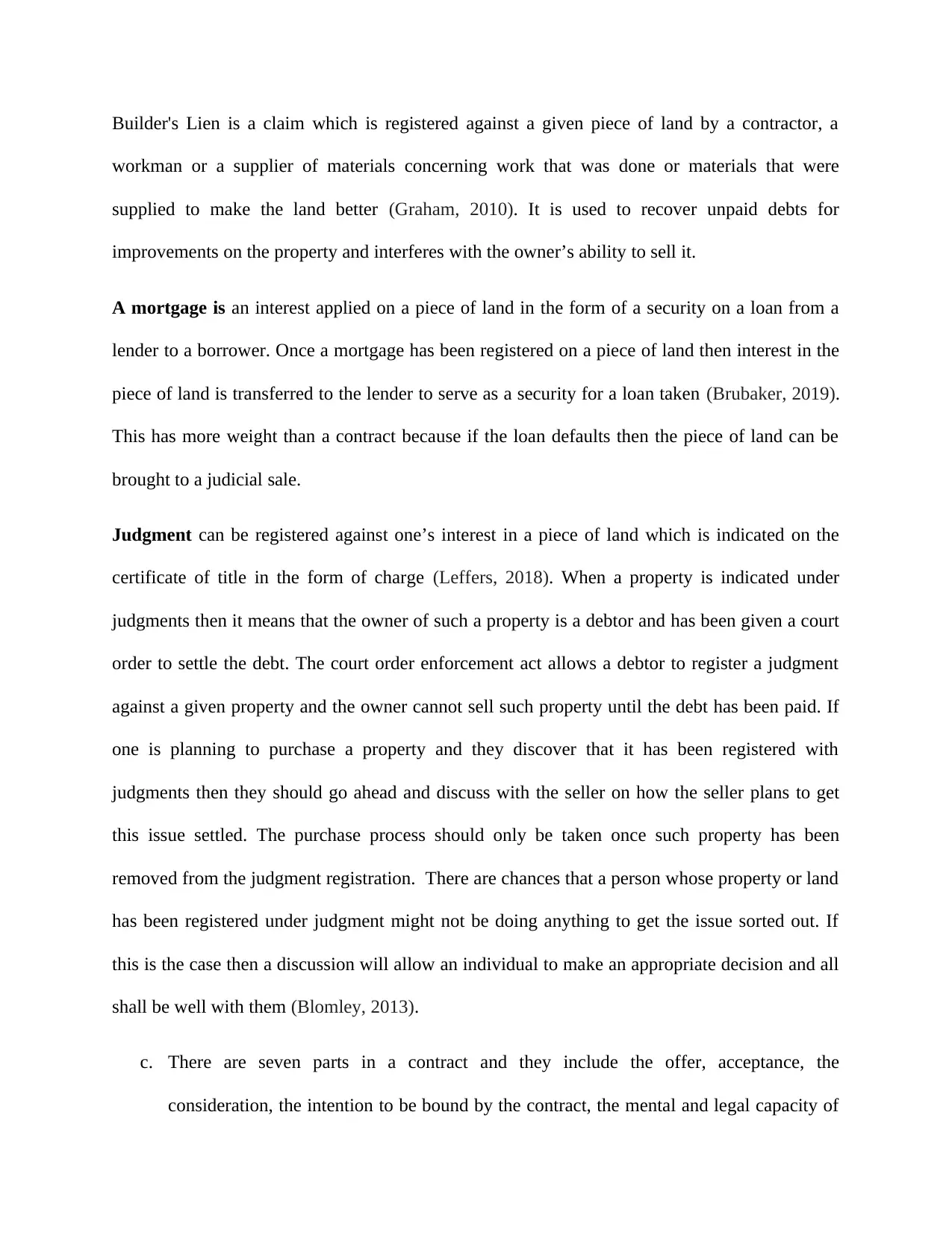
Builder's Lien is a claim which is registered against a given piece of land by a contractor, a
workman or a supplier of materials concerning work that was done or materials that were
supplied to make the land better (Graham, 2010). It is used to recover unpaid debts for
improvements on the property and interferes with the owner’s ability to sell it.
A mortgage is an interest applied on a piece of land in the form of a security on a loan from a
lender to a borrower. Once a mortgage has been registered on a piece of land then interest in the
piece of land is transferred to the lender to serve as a security for a loan taken (Brubaker, 2019).
This has more weight than a contract because if the loan defaults then the piece of land can be
brought to a judicial sale.
Judgment can be registered against one’s interest in a piece of land which is indicated on the
certificate of title in the form of charge (Leffers, 2018). When a property is indicated under
judgments then it means that the owner of such a property is a debtor and has been given a court
order to settle the debt. The court order enforcement act allows a debtor to register a judgment
against a given property and the owner cannot sell such property until the debt has been paid. If
one is planning to purchase a property and they discover that it has been registered with
judgments then they should go ahead and discuss with the seller on how the seller plans to get
this issue settled. The purchase process should only be taken once such property has been
removed from the judgment registration. There are chances that a person whose property or land
has been registered under judgment might not be doing anything to get the issue sorted out. If
this is the case then a discussion will allow an individual to make an appropriate decision and all
shall be well with them (Blomley, 2013).
c. There are seven parts in a contract and they include the offer, acceptance, the
consideration, the intention to be bound by the contract, the mental and legal capacity of
workman or a supplier of materials concerning work that was done or materials that were
supplied to make the land better (Graham, 2010). It is used to recover unpaid debts for
improvements on the property and interferes with the owner’s ability to sell it.
A mortgage is an interest applied on a piece of land in the form of a security on a loan from a
lender to a borrower. Once a mortgage has been registered on a piece of land then interest in the
piece of land is transferred to the lender to serve as a security for a loan taken (Brubaker, 2019).
This has more weight than a contract because if the loan defaults then the piece of land can be
brought to a judicial sale.
Judgment can be registered against one’s interest in a piece of land which is indicated on the
certificate of title in the form of charge (Leffers, 2018). When a property is indicated under
judgments then it means that the owner of such a property is a debtor and has been given a court
order to settle the debt. The court order enforcement act allows a debtor to register a judgment
against a given property and the owner cannot sell such property until the debt has been paid. If
one is planning to purchase a property and they discover that it has been registered with
judgments then they should go ahead and discuss with the seller on how the seller plans to get
this issue settled. The purchase process should only be taken once such property has been
removed from the judgment registration. There are chances that a person whose property or land
has been registered under judgment might not be doing anything to get the issue sorted out. If
this is the case then a discussion will allow an individual to make an appropriate decision and all
shall be well with them (Blomley, 2013).
c. There are seven parts in a contract and they include the offer, acceptance, the
consideration, the intention to be bound by the contract, the mental and legal capacity of
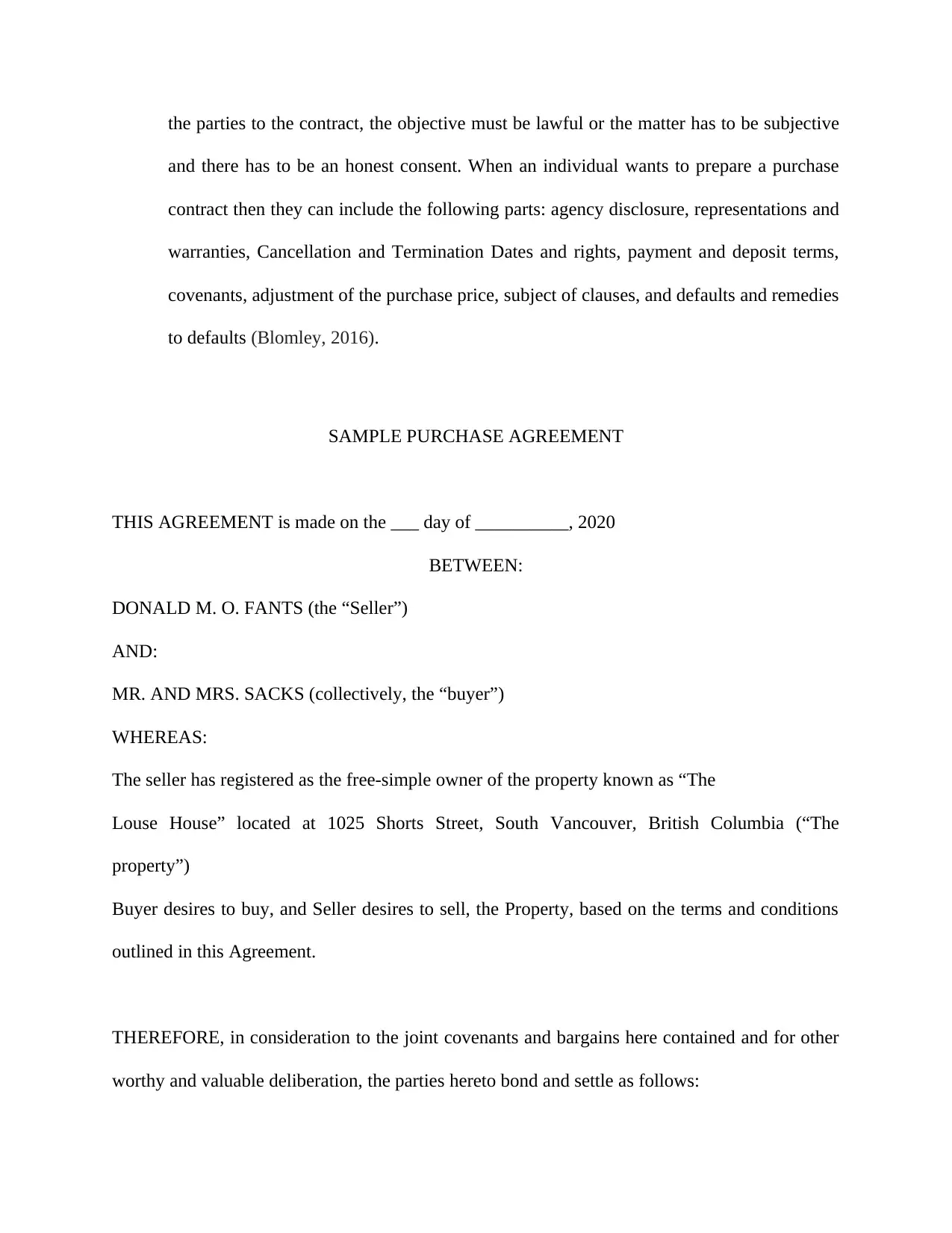
the parties to the contract, the objective must be lawful or the matter has to be subjective
and there has to be an honest consent. When an individual wants to prepare a purchase
contract then they can include the following parts: agency disclosure, representations and
warranties, Cancellation and Termination Dates and rights, payment and deposit terms,
covenants, adjustment of the purchase price, subject of clauses, and defaults and remedies
to defaults (Blomley, 2016).
SAMPLE PURCHASE AGREEMENT
THIS AGREEMENT is made on the ___ day of __________, 2020
BETWEEN:
DONALD M. O. FANTS (the “Seller”)
AND:
MR. AND MRS. SACKS (collectively, the “buyer”)
WHEREAS:
The seller has registered as the free-simple owner of the property known as “The
Louse House” located at 1025 Shorts Street, South Vancouver, British Columbia (“The
property”)
Buyer desires to buy, and Seller desires to sell, the Property, based on the terms and conditions
outlined in this Agreement.
THEREFORE, in consideration to the joint covenants and bargains here contained and for other
worthy and valuable deliberation, the parties hereto bond and settle as follows:
and there has to be an honest consent. When an individual wants to prepare a purchase
contract then they can include the following parts: agency disclosure, representations and
warranties, Cancellation and Termination Dates and rights, payment and deposit terms,
covenants, adjustment of the purchase price, subject of clauses, and defaults and remedies
to defaults (Blomley, 2016).
SAMPLE PURCHASE AGREEMENT
THIS AGREEMENT is made on the ___ day of __________, 2020
BETWEEN:
DONALD M. O. FANTS (the “Seller”)
AND:
MR. AND MRS. SACKS (collectively, the “buyer”)
WHEREAS:
The seller has registered as the free-simple owner of the property known as “The
Louse House” located at 1025 Shorts Street, South Vancouver, British Columbia (“The
property”)
Buyer desires to buy, and Seller desires to sell, the Property, based on the terms and conditions
outlined in this Agreement.
THEREFORE, in consideration to the joint covenants and bargains here contained and for other
worthy and valuable deliberation, the parties hereto bond and settle as follows:
⊘ This is a preview!⊘
Do you want full access?
Subscribe today to unlock all pages.

Trusted by 1+ million students worldwide
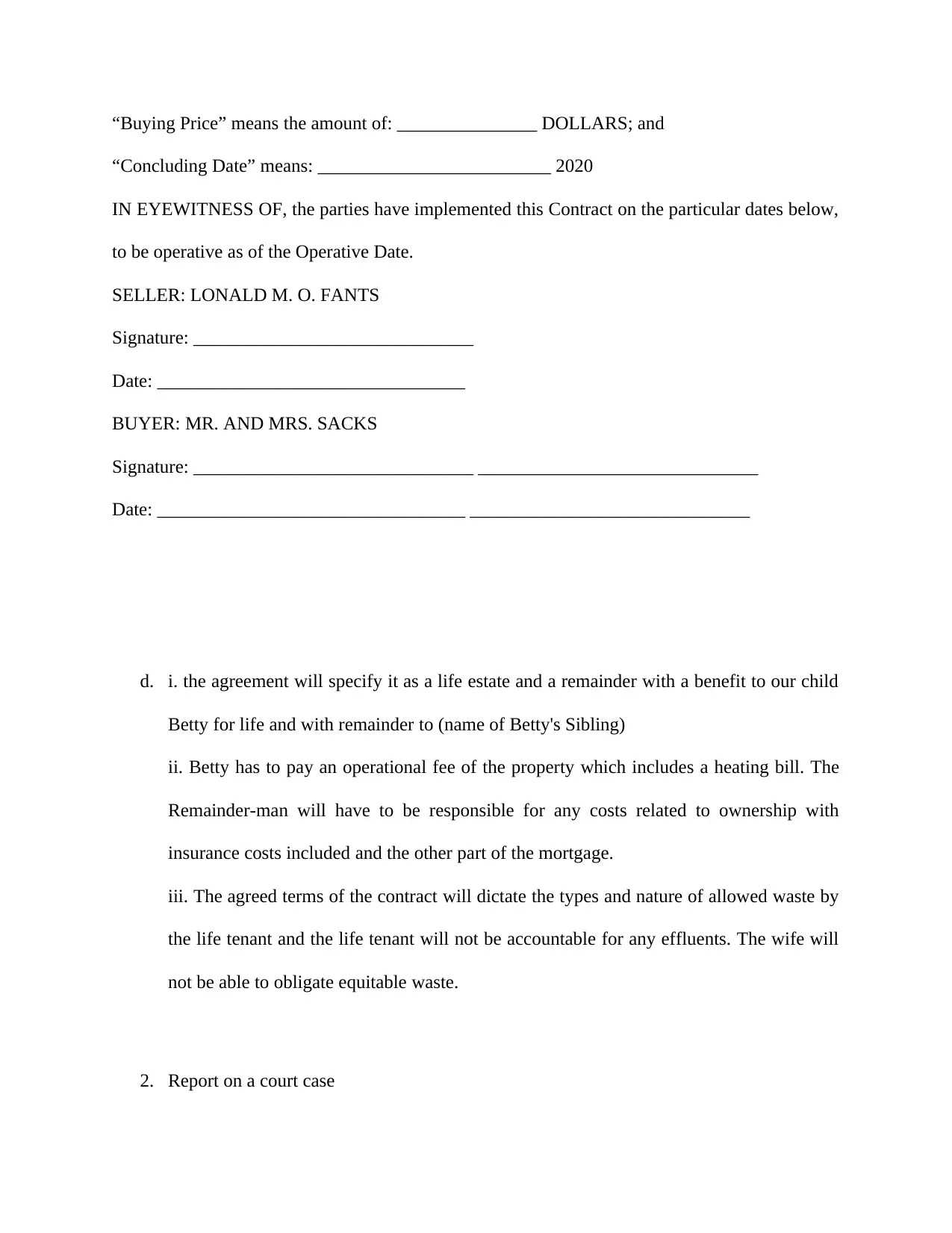
“Buying Price” means the amount of: _______________ DOLLARS; and
“Concluding Date” means: _________________________ 2020
IN EYEWITNESS OF, the parties have implemented this Contract on the particular dates below,
to be operative as of the Operative Date.
SELLER: LONALD M. O. FANTS
Signature: ______________________________
Date: _________________________________
BUYER: MR. AND MRS. SACKS
Signature: ______________________________ ______________________________
Date: _________________________________ ______________________________
d. i. the agreement will specify it as a life estate and a remainder with a benefit to our child
Betty for life and with remainder to (name of Betty's Sibling)
ii. Betty has to pay an operational fee of the property which includes a heating bill. The
Remainder-man will have to be responsible for any costs related to ownership with
insurance costs included and the other part of the mortgage.
iii. The agreed terms of the contract will dictate the types and nature of allowed waste by
the life tenant and the life tenant will not be accountable for any effluents. The wife will
not be able to obligate equitable waste.
2. Report on a court case
“Concluding Date” means: _________________________ 2020
IN EYEWITNESS OF, the parties have implemented this Contract on the particular dates below,
to be operative as of the Operative Date.
SELLER: LONALD M. O. FANTS
Signature: ______________________________
Date: _________________________________
BUYER: MR. AND MRS. SACKS
Signature: ______________________________ ______________________________
Date: _________________________________ ______________________________
d. i. the agreement will specify it as a life estate and a remainder with a benefit to our child
Betty for life and with remainder to (name of Betty's Sibling)
ii. Betty has to pay an operational fee of the property which includes a heating bill. The
Remainder-man will have to be responsible for any costs related to ownership with
insurance costs included and the other part of the mortgage.
iii. The agreed terms of the contract will dictate the types and nature of allowed waste by
the life tenant and the life tenant will not be accountable for any effluents. The wife will
not be able to obligate equitable waste.
2. Report on a court case
Paraphrase This Document
Need a fresh take? Get an instant paraphrase of this document with our AI Paraphraser
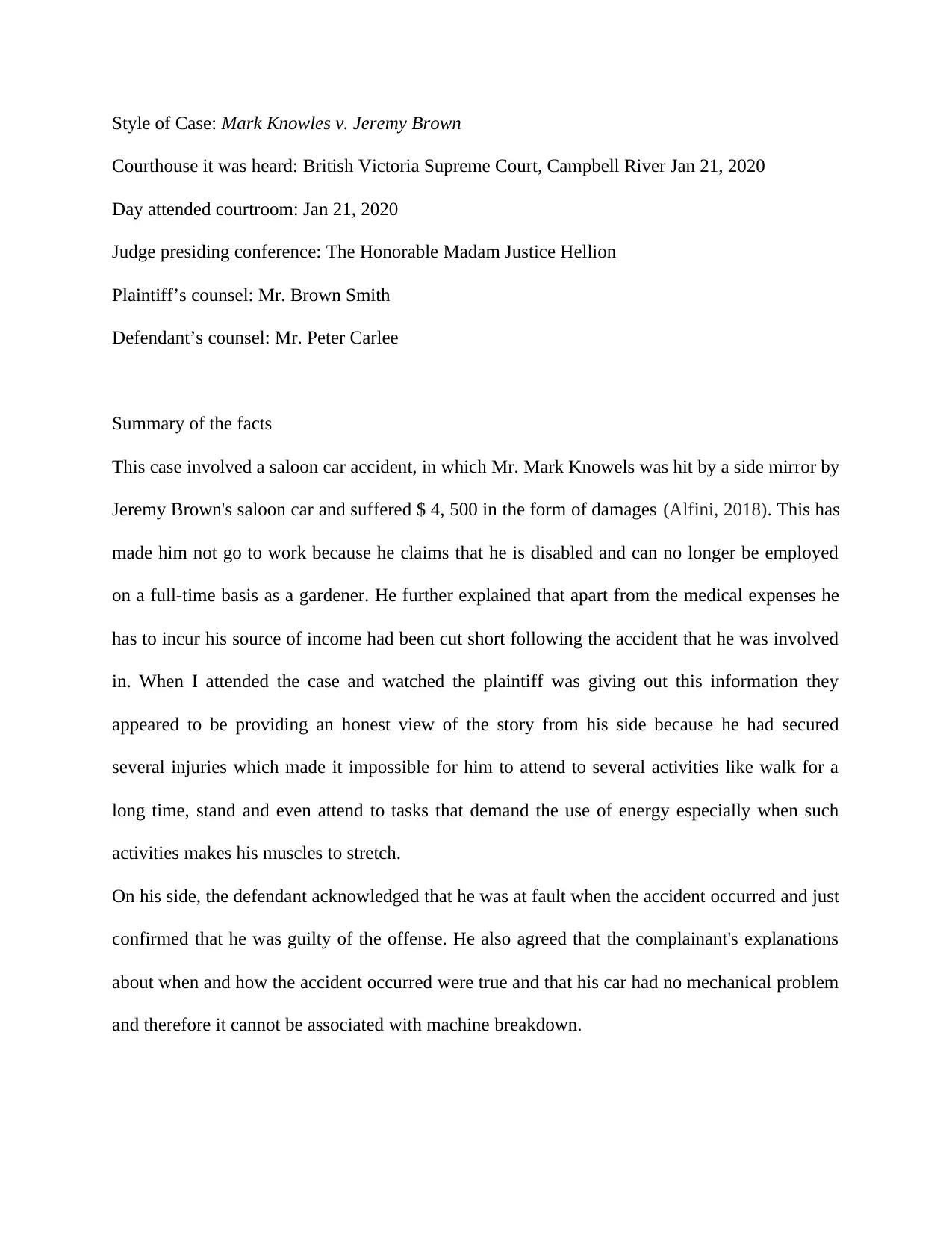
Style of Case: Mark Knowles v. Jeremy Brown
Courthouse it was heard: British Victoria Supreme Court, Campbell River Jan 21, 2020
Day attended courtroom: Jan 21, 2020
Judge presiding conference: The Honorable Madam Justice Hellion
Plaintiff’s counsel: Mr. Brown Smith
Defendant’s counsel: Mr. Peter Carlee
Summary of the facts
This case involved a saloon car accident, in which Mr. Mark Knowels was hit by a side mirror by
Jeremy Brown's saloon car and suffered $ 4, 500 in the form of damages (Alfini, 2018). This has
made him not go to work because he claims that he is disabled and can no longer be employed
on a full-time basis as a gardener. He further explained that apart from the medical expenses he
has to incur his source of income had been cut short following the accident that he was involved
in. When I attended the case and watched the plaintiff was giving out this information they
appeared to be providing an honest view of the story from his side because he had secured
several injuries which made it impossible for him to attend to several activities like walk for a
long time, stand and even attend to tasks that demand the use of energy especially when such
activities makes his muscles to stretch.
On his side, the defendant acknowledged that he was at fault when the accident occurred and just
confirmed that he was guilty of the offense. He also agreed that the complainant's explanations
about when and how the accident occurred were true and that his car had no mechanical problem
and therefore it cannot be associated with machine breakdown.
Courthouse it was heard: British Victoria Supreme Court, Campbell River Jan 21, 2020
Day attended courtroom: Jan 21, 2020
Judge presiding conference: The Honorable Madam Justice Hellion
Plaintiff’s counsel: Mr. Brown Smith
Defendant’s counsel: Mr. Peter Carlee
Summary of the facts
This case involved a saloon car accident, in which Mr. Mark Knowels was hit by a side mirror by
Jeremy Brown's saloon car and suffered $ 4, 500 in the form of damages (Alfini, 2018). This has
made him not go to work because he claims that he is disabled and can no longer be employed
on a full-time basis as a gardener. He further explained that apart from the medical expenses he
has to incur his source of income had been cut short following the accident that he was involved
in. When I attended the case and watched the plaintiff was giving out this information they
appeared to be providing an honest view of the story from his side because he had secured
several injuries which made it impossible for him to attend to several activities like walk for a
long time, stand and even attend to tasks that demand the use of energy especially when such
activities makes his muscles to stretch.
On his side, the defendant acknowledged that he was at fault when the accident occurred and just
confirmed that he was guilty of the offense. He also agreed that the complainant's explanations
about when and how the accident occurred were true and that his car had no mechanical problem
and therefore it cannot be associated with machine breakdown.
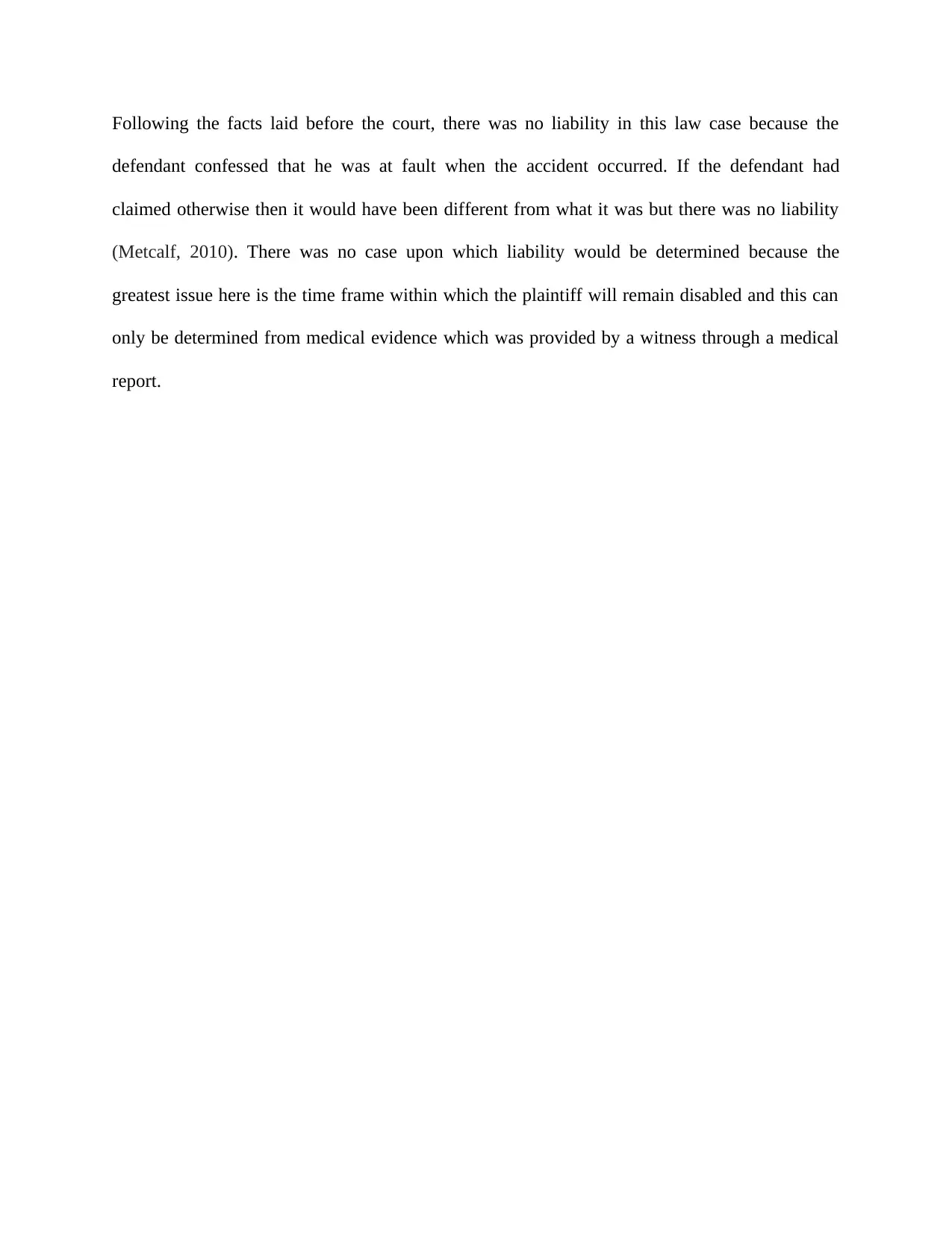
Following the facts laid before the court, there was no liability in this law case because the
defendant confessed that he was at fault when the accident occurred. If the defendant had
claimed otherwise then it would have been different from what it was but there was no liability
(Metcalf, 2010). There was no case upon which liability would be determined because the
greatest issue here is the time frame within which the plaintiff will remain disabled and this can
only be determined from medical evidence which was provided by a witness through a medical
report.
defendant confessed that he was at fault when the accident occurred. If the defendant had
claimed otherwise then it would have been different from what it was but there was no liability
(Metcalf, 2010). There was no case upon which liability would be determined because the
greatest issue here is the time frame within which the plaintiff will remain disabled and this can
only be determined from medical evidence which was provided by a witness through a medical
report.
⊘ This is a preview!⊘
Do you want full access?
Subscribe today to unlock all pages.

Trusted by 1+ million students worldwide
1 out of 14
Related Documents
Your All-in-One AI-Powered Toolkit for Academic Success.
+13062052269
info@desklib.com
Available 24*7 on WhatsApp / Email
![[object Object]](/_next/static/media/star-bottom.7253800d.svg)
Unlock your academic potential
Copyright © 2020–2025 A2Z Services. All Rights Reserved. Developed and managed by ZUCOL.



![LLB Criminal Law Case Study: R v Seed; R v Stark [2007] EWCA Crim 254](/_next/image/?url=https%3A%2F%2Fdesklib.com%2Fmedia%2Fimages%2Fzw%2F226637320389411aa1571119b4239a47.jpg&w=256&q=75)